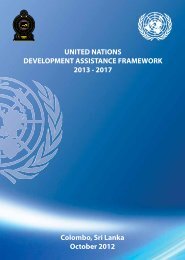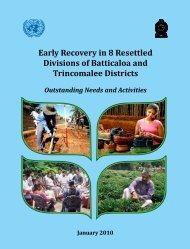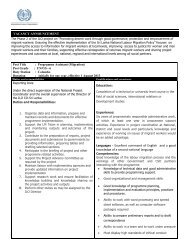Sri Lanka Human Development Report 2012.pdf
Sri Lanka Human Development Report 2012.pdf
Sri Lanka Human Development Report 2012.pdf
You also want an ePaper? Increase the reach of your titles
YUMPU automatically turns print PDFs into web optimized ePapers that Google loves.
Technological advancements and transfer of<br />
technology<br />
Acquiring and adapting technology to local conditions can<br />
produce transformational changes if the process is robust<br />
enough to push productivity forward and strengthen<br />
international competitiveness. This requires sustained<br />
investment, an appropriate business environment, and<br />
capacities for research and technology customization.<br />
In <strong>Sri</strong> <strong>Lanka</strong>, gaps in technological advancements and<br />
technology transfer are particularly acute in agriculture,<br />
where investments in research and extension services<br />
have been inadequate, limiting opportunities to improve<br />
yields. Even in major irrigation areas, rice yields are lower<br />
than could be expected. 270 The outputs of agricultural<br />
food crops have been stagnating for over 20 years, and<br />
are comparatively low by developing country standards,<br />
except for rice. The investment in agricultural research<br />
that powered <strong>Sri</strong> <strong>Lanka</strong>’s Green Revolution starting in the<br />
1970s dropped in 1977. 271 Since 1981, expenditure on<br />
agricultural research and extension has been less than 0.05<br />
percent of agricultural GDP. 272<br />
According to the World Bank, weak agricultural extension<br />
services pose a major challenge to productivity. 273 While<br />
knowledge of new technologies is an important factor<br />
influencing productivity, 274 extension services provide a<br />
bridge ensuring that this reaches farmers and is adapted<br />
appropriately.<br />
<strong>Sri</strong> <strong>Lanka</strong>ns on average can reach an agrarian service centre<br />
in about 36 minutes. It takes between 43 and 48 minutes<br />
for people in the districts of Nuwara Eliya, Badulla,<br />
Ratnapura, Kegalle and Moneragala. In Jaffna, Matale<br />
and Batticaloa, services are accessible in 27 to 28 minutes<br />
(Table A26). Landless and marginal farmers have the least<br />
access to these services. 275<br />
Accessibility is, however, only one issue. A number of<br />
structural problems hinder the system, including the high<br />
number of organizations involved, which have different<br />
mandates and approaches. 276 The government extension<br />
service is the largest and of central importance to small-scale<br />
farmers. Some private sector companies provide advisory<br />
services as well. After the devolution of the agricultural<br />
and livestock extension service from central to provincial<br />
ministries around 1995, there was little coordination<br />
among them. Links between research and extension<br />
services weakened, as the research component is the<br />
responsibility of the central Government, while provincial<br />
councils are more responsible for the services. 277 At the<br />
same time, the restructuring of provincial departments<br />
and the involvement of field offices in administrative<br />
work reduced interactions between extension workers and<br />
farmers.<br />
Other factors affecting the adaptation of technology by<br />
farmers are illustrated by rice cultivation. Though the use<br />
of improved varieties is high, poor quality seeds result<br />
in low yields. A lack of capital, the non-availability of<br />
certified seeds in required quantities at the appropriate<br />
time, and lack of awareness of the importance of seed<br />
quality contribute to the problem. Additional barriers to<br />
innovation include socioeconomic conditions, high risks<br />
of crop failure through dependence on rain and smallscale<br />
irrigation systems, subsistence farming and nonavailability<br />
of agricultural inputs. 278<br />
Work to beef up extension services is being complemented<br />
by experiments such as the cyber-extension service of the<br />
Department of Agriculture. It uses electronic media for<br />
disseminating information to extension agents and farmers,<br />
and encourages farmers to use interactive CDs, email<br />
and Internet facilities to access new knowledge. Farmers<br />
can communicate with the Department to obtain advice<br />
and assistance in solving farming problems. Plans call for<br />
establishing 220 cyber-extension units. While 49 have<br />
been set up so far, only a few have Internet connections.<br />
Use is low because of poor Internet connectivity, the<br />
limited technology skills of extension agents and farmers,<br />
and a lack of awareness about availability.<br />
The Department has also been active in establishing a tollfree<br />
line for agricultural advice, and using television and<br />
community radio broadcasts to disseminate information<br />
to rural areas. 279 The Vidatha programme targets small<br />
and medium-sized farm enterprises. It seeks to identify<br />
community resources and needs, and bring these to the<br />
96<br />
sri lanka <strong>Human</strong> <strong>Development</strong> report 2012






